#kohbar
Text
Kohbar painting Handmade art work

2 notes
·
View notes
Text
Kohbar Ki Shart (कोहबर की शर्त) by Keshab Prasad Mistra pdf
Kohbar Ki Shart (कोहबर की शर्त) by Keshab Prasad Mistra, Hindi book pdfe-book name- Kohbar Ki Shart (कोहबर की शर्त)Author- Keshav Prasad Mistra (केशव प्रसाद मिश्र)Book Type- Hindi novelFile Format- PDFLanguage- HindiPages- 209Pdf size- 2MbQuality- Good, without any watermark
केशव प्रसाद मिश्र :जन्म : 26 जुलाई, 19261 जन्म स्थान : ग्राम बलिहार, जिला बलिया (उ. प्र.) में। शिक्षा : एम.ए. अर्थशास्त्र,…
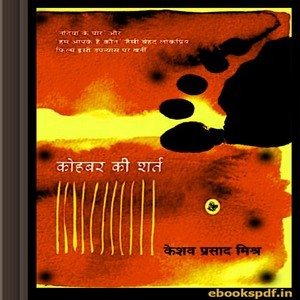
View On WordPress
0 notes
Text
5 Distinctive Styles of Madhubani Painting

5 DISTINCTIVE STYLES OF MADHUBANI PAINTING
Madhubani painting is one of the most famous Indian art forms. It was traditionally created by women. Women were from the Mithila region of Bihar and that's why it is known as Mithila painting or Madhubani painting. The colors used in Madhubani paintings are mainly made from plants and other natural sources. This painting can be drawn on canvas, cloth, and handmade paper. Following are five styles of Madhubani painting.
Bharni Style
Bharni means filling. This is one of the most famous styles of Madhubani painting. In Madhubani painting, vibrant colors are mostly used on canvas. It was practiced mainly by upper caste people which depicted mythological characters in epics, especially the Ramayana and Mahabharata which the womenfolk knew from the continued recital. Mostly the enclosed areas are filled with vibrant colors like blue, yellow, pink, green, orange colors etc. and the subject is outlined in black.
Tantrik Style
Tantrik painting is distinguished from another style of Madhubani painting. It solely depicts religious texts and characters related to them. Tantrik subjects include manifestations of Maha Kali, Maha Durga, Maha Saraswati, Maha Lakshmi, and Maha Ganesh along with other tantrik symbols.
Katchni Style
In this style of painting, only one or two colors are used. The finest details are created and the fine pattern is made with hatching and stippling. This painting is still practiced by Kayasthas of the society. As Katchni means lines, they optimize muted hues, mostly the figures.
Godna Style
This is a simple style of Madhubani painting. Godna is commonly known as a tattoo in today's life and it was first done by Chano Devi. It was done on arms and legs. At the first initiative, a pointed bamboo pen with lampblack ink was used. This style has concentric circles of flowers, fields, animals, figures, and spirit.
Kohbar
The painting which is painted on the wall of a kohbar is known as Kohbar. The Kohbar painting is filled with rich details, each contributing significantly to the meaning of the whole. This is practiced by the lower class of society. They wash the paper with cow dung and paintings are done using earth colors.
Penkraft conducts classes, course, online courses, live courses, workshops, teachers' training & online teachers' training in Handwriting Improvement, Calligraphy, Abacus Maths, Vedic Maths, Phonics and various Craft & Artforms - Madhubani, Mandala, Warli, Gond, Lippan Art, Kalighat, Kalamkari, Pichwai, Cheriyal, Kerala Mural, Pattachitra, Tanjore Painting, One Stroke Painting, Decoupage, Image Transfer, Resin Art, Fluid Art, Alcohol Ink Art, Pop Art, Knife Painting, Scandinavian Art, Water Colors, Coffee Painting, Pencil Shading, Resin Art Advanced etc. at pan-India locations. With our mission to inspire, educate, empower & uplift people through our endeavours, we have trained & operationally supported (and continue to support) 1500+ home-makers to become Penkraft Certified Teachers? in various disciplines.
0 notes
Text
Learn an Exclusive Art Work - MADHUBANI Paintings
The name Madhubhani means Backwoods of Honey. The workmanship is made on the walls that have been put with cow fertilizer and mud glue to deliver a dull foundation. The female individuals from the house rehearsed the craftsmanship. It filled in as an imaginative articulation device for their daily existences and happenings. With the conviction that Divine beings visited each house in the first part of the day hours, the workmanship fundamentally wore the walls and entryways, expecting to please and invite the Divine beings.
Madhubani painting are said to have started during the time of Ramayana, when Ruler Janaka dispatched craftsmen to do canvases during the wedding of his little girl, Sita to Master Smash. The artworks normally portrayed nature and Hindu strict themes, the topics by and large spin around Hindu gods. Normal articles like the sun, moon, and strict plants like tulsi (hallowed basil) are additionally generally painted, alongside scenes from the imperial court and get-togethers like weddings. For the most part no space is left vacant, the holes are loaded up with blossoms, creatures, birds, and, surprisingly, mathematical plans. The composition was one of the abilities that was passed down from one age to another in the groups of the Mithila Area, mostly among ladies. The artworks were made on the walls during celebrations, strict occasions, and different achievements of the life-cycle like birth, Upanayanam (Consecrated string service), and marriage. The "kohbar ghar" canvases, which are made on the marital chamber, were customarily made to favor the recently hitched couple and the fundamental subject of these compositions for the most part rotates around affection and richness. The images of richness and success incorporate sun, moon, parrot, elephant, fish, turtle, bamboo tree, lotus, and so on. The tones utilized are splendid - blue, dark, dark red, light yellow, pink, lemon and green and these made the right state of mind and assumed a significant part. The radiant red and yellow portray energy, enthusiasm and the limiting power.
Among the main present day pariahs to record the custom of Madhubani works of art were William and Mildred Bowman. Bowman was an English government worker relegated to the locale during the provincial time. The Bowmen acquired a few drawings on paper that the ladies painters were utilizing as helps to memory. Works that the Bowmen gathered went to the India Records Office in London (presently part of the English Library) where few experts could concentrate on them as imaginative examples of India's people craftsmanship.
Madhubani Workmanship earned respect in India in the last part of the 1960's. After a dry season in the district there was an extreme monetary emergency. To make another wellspring of non-agrarian pay, the All-India Crafted works Board urged the ladies craftsmen to deliver their conventional artistic creations on hand tailored paper for business deal. From that point forward, painting has turned into an essential kind of revenue for scores of families. It is a recognition for the creativity of the ladies of Mithila who have effectively moved their methods of bhitti chitra or wall-painting to the mode of paper.
Generally, normal tones were utilized that were gotten from plant extricates like henna leaves, blossom, bougainvillea, neem, and so on. Then, at that point, to make the paint adhere to the artwork medium, these normal juices are blended in with banana leaves tar and standard gum. Lately, engineered colors that come in powdered structure are effectively accessible on the lookout. In any case, conventional specialists actually use tones got from regular sources. The most well known normal tones in Madhubani workmanship incorporate dark red which is gotten from Kusuma bloom, dark from consumed jowar, green from Bel trees, orange from Palasa blossom and light yellow from turmeric blended in with banyan leaf milk. Two various types of brushes are utilized one for little subtleties that is made from bamboo twigs and the other for occupying in the space that is produced using a little piece of material joined to a twig.
Strangely, Madhubani compositions have three recognized styles:
1. Brahmin Style - The Brahmins are the upper most rank in the Hindu culture and the canvases made by them were permitted liberal utilization of energetic varieties and their artworks were roused by the hallowed texts with accounts of different Hindu Divine beings and Goddesses like Slam, Seetha, Krishna, Durga and Shiva.
2. Kshatriya Style - The Kshatriyas are a little underneath the Brahmins in the standing order and were permitted the utilization of just dark and red tones. The subjects of the artistic creations were comparable as the Brahmin style.
3. Tatoo Style - The Dusadhs are the low standing gathering and they were not permitted to address divinities but rather they could utilize brilliant varieties. Subsequently their subjects incorporated the widely varied vegetation, and of Ruler Salhesh - a Dusadh social legend. This style is known as Tattoo or Godhana painting.
For more details, visit us :
Buy Carved Wood Art Online In India
Phad painting
Rogan Art Painting
Pattachitra Art Painting
#wood carving#Buy Carved Wood Art Online In India#Phad painting#Rogan Art Painting#Pattachitra Art Painting#Indian handicrafts
0 notes
Text
The Kohbar of Lotus, Bamboo, and Clove - a new Kohbar for a new Generation
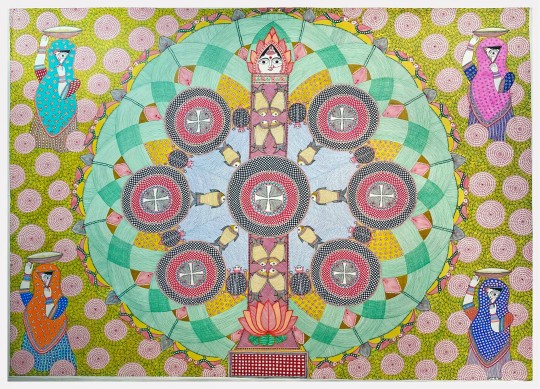
The kohbar image painted on the wall of a marriage room serves as a talisman to produce a fruitful union and protect the ceremony from the evil eye. The painting must follow a traditional iconography to be effective but in her Kohbar the artist Amrita Das only used some of its elements to produce a recognizable but abstract image of the kohbar. She said she was “only thinking of Lotus, Bamboo, and the sweet smell of Cloves”.
In the center, the Lotus plant with its many leaves represents female fertility - always the dominant image in the traditional kohbar as it is here. The light and dark intersecting green lines represent a stylized Bamboo grove, the male element. Typically the Bamboo grove is much smaller than the Lotus and often gets lost in all the traditional decorative elements of fish, birds and other auspicious images but with her Bamboo grove Amrita Das breaks completely with the accepted iconography and makes a deliberate and significant change. She depicts the Bamboo and the Lotus, the male and the female elements, as equals, the one embracing the other set in a field of red clove flowers which Amrita Das calls “ the spice of married life”. Cloves play an important role in Hindu ritual. They are offered to the gods in temples and protect babies and newly married couples from the evil eye. The four naina-jogins that are painted in the four corners of the marriage room are also present in the four corners of her Kohbar.

Amrita Das’ Kohbar began as an inchoate idea, not even conscious perhaps, when Tara Books invited the artist down to Chennai for a book making workshop some time ago. The result was the wonderful Hope is a Girl Selling Fruit, a book of paintings and prose, in which she muses on what it means to be a girl and considers her own future. The life of girls is hard from childhood on. There was always housework to do and no moment for oneself. No time to even dream. Would this ever end she thought. Would she ever have some time for herself? And even marriage, would that finally give her some freedom?
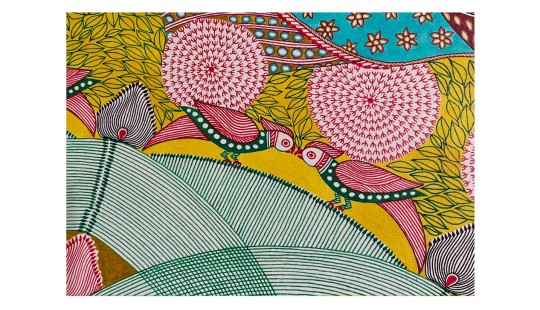
Six years after her marriage Amrita Das answers the question of marriage and freedom for women with her vision of a new kohbar in The Kohbar of Lotus, Bamboo, and Clove. She sees this new Kohbar not as a ritual formula for fertility but rather as a union here on earth of the cosmic male and female forces in the universe - the Bamboo and Lotus, two wreaths circling each other, are Shiva and Parvati as the god Ardhanarishvara, half male and half female in one body, together but separate.
The Lotus, Bamboo and Clove is the third kohbar painting that I’m aware of in the last couple of years which promotes Ardhanarishwara as the example of a marriage based on equality and respect for the female and the male. Such a marriage is one in which there is freedom. This is what Amrita Das’ revolutionary painting promises, a new traditional Kohbar for a new generation.

Amrita Das, The Kohbar of Lotus, Bamboo, and Clove, acrylic on a single sheet of Canson art paper, 4x3 feet, 2019. Signed and available.
.
2 notes
·
View notes
Photo

*OBJECT OF THE WEEK-76* (08th to 14th October 2021) *Sita Swember/Swyamvar aur Kohabar* (Madhubani painting on canvas) वेबसाइट की लिंक / Website link -https://igrms.com/wordpress/?page_id=6566 #AmritMahotsav #EkBharatShreshthaBharat #MinistryOfCulture #PMOIndia #GKishanReddy #ArjunRamMeghwal #MeenakshiLekhi #igrms @Minis @PMOIndia @MDoNER_India @AmritMahotsav @kishanreddybjp @arjunrammeghwal @M_Lekhi @secycultureGOI @PIBCulture The object of this week is a multicoloured Madhubani painting on canvas depicting the story of Sita swyamvar and Kohabar. It is generally made on the occasion of marriage ceremony. Madhubani painting also known as Mithila painting is a traditional form of painting originated in Madhubani district of Bihar. It is mainly done by the women of different communities in the Mithila region but now it has been practiced both by men and women. Traditionally the painting is done on the mud plastered walls and floors of the houses during auspicious occassions like Vivaha, Mundan, Upanayan, Dushera, Deepawali and other Vratas. But looking at the value and folk elements of the painting now the artisans have converted it on paper, canvas, cloth and other mediums. The main theme of these paintings are related to the social and religions phenomena. This painting on canvas depicts "Kohabar" in the central part. Kohabar is made inside the honeymoon room for newly married couple to get blessing from god and goddess and family members. On the left side scene of Sita Sawyamvar and procession of musician is depicted. On the right side procession of groom and bride is shown. Acc. No. 2004.283 Local Name – Sita Swember/Swyamvar aur Kohabar -Madhubani painting on canvas Tribe/Community – Folk Locality – Madhubani, Bihar Measurement - Length - 497.5 cm., Breadth - 180 cm., Thickness 3 cm. #Kohabar #sitaswayamvar #madhubanipainting #folk #folkpainting #madhubani #bihar #kohbar #kohbarart #igrms #museumfromhome #objectoftheweek #ethnograhicobject #museumobject #museumofman #museumofmankind #museumofhumankind #experienceigrms #igrmsstories #staysafe #covid19 https://www.instagram.com/p/CWABFqSDt_f/?utm_medium=tumblr
#amritmahotsav#ekbharatshreshthabharat#ministryofculture#pmoindia#gkishanreddy#arjunrammeghwal#meenakshilekhi#igrms#kohabar#sitaswayamvar#madhubanipainting#folk#folkpainting#madhubani#bihar#kohbar#kohbarart#museumfromhome#objectoftheweek#ethnograhicobject#museumobject#museumofman#museumofmankind#museumofhumankind#experienceigrms#igrmsstories#staysafe#covid19
0 notes
Photo

Watch the video on #youtube #youtuber #mithila #kohbar https://youtu.be/KoOFJRke6w4 https://www.instagram.com/p/COLQtqsl0l8/?igshid=72fopb9gdr9q
0 notes
Photo










Did I mention I liked Destiny?
No?
I like Destiny.


#destiny oc#cher#destiny 2#cayde-6#ikora rey#Cmmander zavala#oc#original character#kohbar#destiny cher#hunter!!!!
6 notes
·
View notes
Photo

Reposted from @yeh_hai_mera_bihar - Background picture credits @shishir.v #Yehhaimerabihar #bihardekhiyegatbhitohsarahiyega #Bihardekhiyeaursunjye #bihar #biharsehai #bihari #bihartourism #biharconnection #biharheritage #biharculture #biharart #madhubanipainting #mithila #kohbar #mithilaart #rituals #tradition #mithilaculture (at Bihar) https://www.instagram.com/p/BsvihlhlKIP/?utm_source=ig_tumblr_share&igshid=tm62rxmhmx2t
#yehhaimerabihar#bihardekhiyegatbhitohsarahiyega#bihardekhiyeaursunjye#bihar#biharsehai#bihari#bihartourism#biharconnection#biharheritage#biharculture#biharart#madhubanipainting#mithila#kohbar#mithilaart#rituals#tradition#mithilaculture
0 notes
Photo

#kohbar #kohbarart #art #painting #madhubani #madhubanipainting #bihar #biharmuseum #patnarocks #patnalife #patnabeats #bvpatna #photography #artphotography #patnalikes (at Bihar Museum)
#kohbar#kohbarart#art#painting#madhubani#madhubanipainting#bihar#biharmuseum#patnarocks#patnalife#patnabeats#bvpatna#photography#artphotography#patnalikes
0 notes
Text
An interactive Mithila art exhibition

In Hindu mythology, a yuga represents the cyclic age of time, which are predestined time periods. As the cyclic age of time progresses from one yuga to another, humanity’s general moral compass progressively degenerates. The cycle of time, the primary theme of the art exhibition, is skillfully depicted in the art exhibition through four artworks titled: ‘Satya Yuga’, ‘Tretā Yuga’, ‘Dvapara Yuga’, and ‘Kali Yuga’, which portray the artist’s visual rendition of the four yugas. Hindu symbolism and iconographies are brimming in every corner of the paintings—gods and asura live together in harmony in ‘Satya Yuga’, Hanuman carries the Dronagiri mountain as Lord Vishnu is reincarnated as Ram in ‘Tretā Yuga’, the tales of Lord Krishna and his mischievous antics in ‘Dvapara Yuga’, the ultimate degeneracy as the powerful destroy the powerless in ‘Kali Yuga’.
Apart from illustrating the tales and lives of Mithila women, Mithila artwork was also a prominent aspect during celebratory occasions such as weddings, sacred rituals, and festivals. The vibrancy of these joyous occasions are captured by Suman and depicted in his artworks, ‘Kohbar Painting’, ‘Ganesh Puja Festival’, ‘Dashami Mela’, ‘Chhath Puja’, and ‘Gauri Puja In The Ramayan’. The ‘Dashami Mela’ is particularly memorable as the artist adroitly uses vivid colours such as red, blue, green, and yellow to depict a festive mood in a Dashain carnival.
The artistic goal of Suman to incorporate contemporary issues through Mithila artwork is reflected in his depiction of the Covid-19 pandemic and its issues through the artworks ‘Scapegoating Bats for the Pandemic’, ‘Covid Lessons’, ‘Lockdown Blues I’, and ‘Lockdown Blues II’. In these artworks, the artist reminds us how humanity’s greed is destroying nature’s ecological balance. Bats, which are quintessential to the ecological balance, are blamed for the pandemic. Trees are felled in countless numbers to make for development projects. In a twist of irony, humans are forced to bring oxygen cylinders in aeroplanes. In a culmination of all our collective greed, the rapid spread of the Covid-19 pandemic resulted in the eerie absence of any humans in buildings, temples, and streets.
Apart from what is actually shown in the artworks, visitors to an art exhibition also derive meaning from how the artworks are presented. In recent times, white cube galleries like the Siddhartha Art Gallery have faced heavy criticism for conferring authority and purity. The pristine, colourless environment of white cube galleries has become a boring cliché. The artworks encased in a glass frame on white background illuminated by overhanging studio lights feel out of reach for the art gallery audience. But in this latest exhibition of SC Suman, the art gallery has attempted to change the boring narrative of a white cube gallery. Colourful sticky notes can be seen adorned near the artworks with feedback from the gallery visitors. In the middle of the ground floor of the art gallery is a bench with sticky notes and sign pens with a note saying ‘INTERACT WITH THE ART’ and ‘PASTE A STICK NOTE NEXT TO YOUR FAVORITE ART PIECE’.
The concept of collecting feedback from visitors is not a novel idea in Siddhartha Art Gallery. A visitor logbook has always been present for visitors to share their impressions of the art exhibitions. A recent entry in the logbook for the current exhibition by Amresh Shah (Janakpur) said, “It’s nice to see my culture in this beautiful representation.” However, the logbook existed more as a formality than as an actual interaction between the artist and visitors.
Now, the walls of Siddhartha Art Gallery with colourful specks of sticky notes create a more welcoming environment than a conventional white cube gallery. “Reminded me of ‘Starry Night’. The Nostalgia” is written on a sticky note near ‘Kali Yuga’ artwork. “Something very gratifying about women in leisure” is written near ‘Women and Water’ artwork. Nevertheless, not all sticky notes are relevant interaction with the art as many sticky notes digress towards other irrelevant themes (“Jimin no got no james” is written on one sticky note).
However, the addition of the sticky notes is an overall positive as artist Suman feels that the addition of sticky notes has allowed him to better understand the impact of his artwork on his audience. “Only people from the older generation prefer to use the logbook to convey their feedback,” says Suman. “However, by introducing the sticky notes this time around, people from the younger generation have also stepped up to provide their feedback.”
The artworks are hypnotisingly captivating as each artwork has intricate details, patterns, and symbols that all have their own meaning and significance. There is a feeling of collective appreciation as one looks at the artwork and reads the accompanying sticky notes. One of them reads-“To inspire someone is a great thing and your art inspires me.” And I couldn’t agree more.
The exhibition will be held until January 15 at Siddhartha Art Gallery, Baber Mahal Revisited.
This content was originally published here.
0 notes
Text
Why Choose Meet Art Creation For Mithila Paintings?
Mithila paintings originated in the Mithila district of India and are usually painted by women on various surfaces on different occasions as a sign of blessings and prosperity. Meet art creation is the best platform to learn and also buy Madhubani paintings online. People from all over the world, especially in the UK and USA can easily learn to paint Madhubani paintings and Madhubani drawings with MetArt creation.
All the Madhubani paintings are easy and beginner-friendly. Madhubani paintings are practiced in various styles ranging from Madhubani Kohbar, Madhubani Tantric paintings, Madhubani Bharni paintings, Godna, and Madhubani Katchni paintings. Today, all these styles have been merged by contemporary Madhubani artists.
Madhubani paintings usually depict religious deities like Madhubani Ram-Sita paintings, Lord Krishna Madhubani paintings, Sarasvati Madhubani paintings, Laxmi, Shiva, and Durga Madhubani paintings. Other symbols include Sun, moon, and other heavenly bodies.
Mithila paintings are easy to learn and can be learned online.
MetArt creation provides an opportunity for people to learn simple Mithila paintings with easy symbols and folk art Madhubani paintings are painted with natural colors and various geometric patterns. These paintings can easily be used as decoration in houses, offices, and other spaces. One can buy various types of Madhubani paintings from us within your budget, like floral Madhubani paintings, Madhubani paintings of birds, Maa Durga Madhubani paintings, etc. Painting is one way to use your energy positively and put your mind in one place. It is also a great exercising technique and is useful in reducing anxiety and depression. The beautiful bright and happy colors used to paint Madhubani paintings bring joy to the Madhubani artists while painting. The creation of art is a therapy in itself and therefore, everyone must learn to paint, be it any style of painting.
https://meetartcreations.com/
0 notes
Text
The Kohbar Resplendent
The artist Shalini Karn has used the Covid lock-down time to present us with a wall-sized (7x7 foot) new interpretation of the Kohbar.

A magnificent Kohbar hovers large over the land its top reaching up into a dark blue sky with barely visible distant mountains.
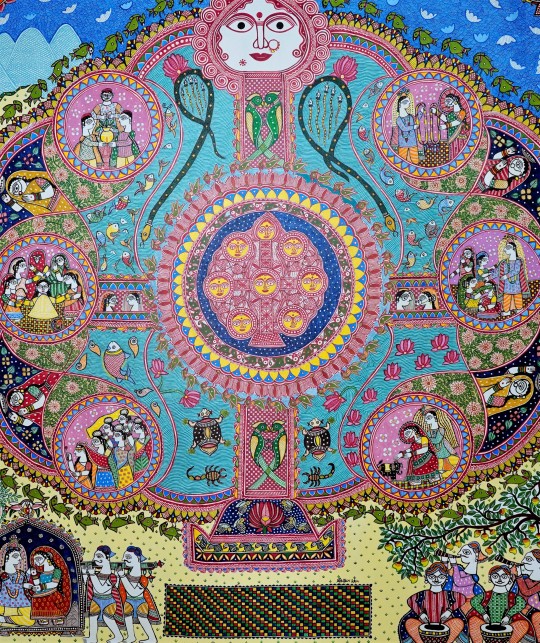
The Kohbar is elaborately decorated. Six symmetrical medallions, three on each side, circle the center while in their four interstices a naina jogin, in red or yellow sari with one eye uncovered, protects the wedding from evil misfortune. The light blue water teems with gaily colored and auspicious life, turtles, small fish, crabs, snakes and lotus flowers.

The Kohbar’s center is a second kohbar,a shining purain of yellow lotus leaves in an architecture of finely drawn red lines set in concentric circles of dark blue water, green parrots, yellow ornamentation, and the red pistils of the lotus plant. This second kohbar is a microcosm of the ‘maha’ (greater) Kohbar that surrounds it and together they are a paean to the power of the feminine.
This Kohbar is a force of love and joy and union.
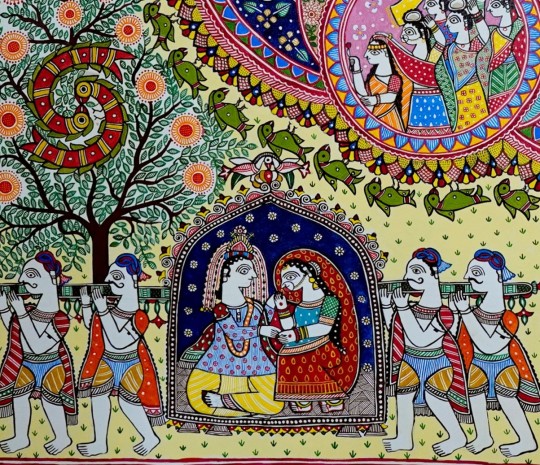
There is no longer the submissive bride alone in the palanquin being taken to an uncertain future but rather husband and wife together, facing each other, hand in hand, being carried to their new life. A pair of entwined love birds in a Kadamba tree sacred to Krishna is next to the palanquin. “And what is Krishna if not love?” asks Shalini Karn.
On the other side are musicians, drummers and horn players, making joyous
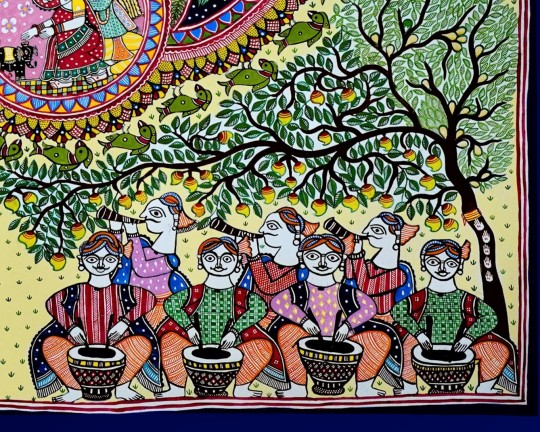
music under a mango and mahua tree where, before the actual wedding ceremony, the bride and groom held a ritual marriage with the trees for a happy and long marriage. Note the bride’s rice paste hand prints on the tree trunk and the yellow string tying the trees together.
You don’t see Shiva and Parvati here. Instead you have Ardhanarishvara,
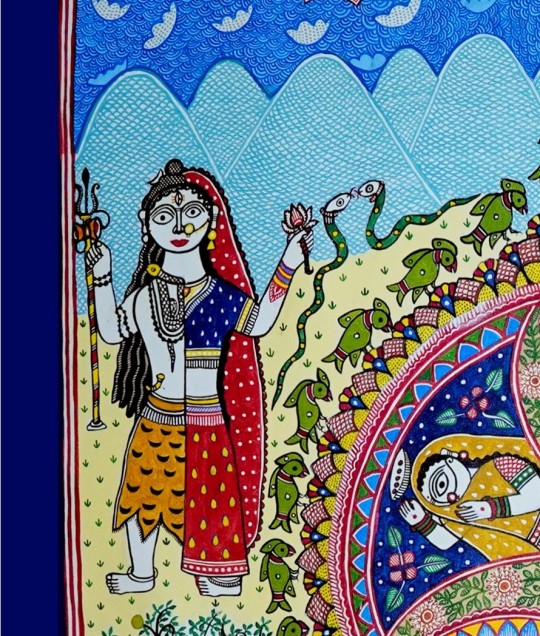
“the Lord who is also a female”, Shiva and Parvati , the union of male and female in one body. This union is now also that of the bride and groom. They have become one.
Shalini Karn is not the first to use Ardhanarishvara as an attempt to give a religious basis for the equality of male and female in the strongly patriarchal society of Bihar. The artist Shalinee Kumari has long struggled with the same question and has also painted a kohbar with Ardhanarishvara. But Shalini Karn by taking the kohbar outside the confines of the marriage room and into the open air has lightened the weight of tradition. She uses the figure of Ardhanarishvara to support the equality of male and female and thus her emphasis is on the love and joy of marriage and the open future of possibilities promised by her Kohbar, glorious over the land and the infinite blue sky.
Shalini Karn, The Kohbar Resplendent, acrylic on canvas, 7x7feet, 2020. The work is signed and is available.
5 notes
·
View notes
Photo

‘सप्ताह का प्रादर्श-76’ (08 से 14 नवम्बर 2021 तक) सीता स्वयंवर और कोहबर (कैनवास पर मधुबनी चित्रकारी) वेबसाइट की लिंक / Website link -https://igrms.com/wordpress/?page_id=6566 #AmritMahotsav #EkBharatShreshthaBharat #MinistryOfCulture #PMOIndia #GKishanReddy #ArjunRamMeghwal #MeenakshiLekhi #igrms @Minis @PMOIndia @MDoNER_India @AmritMahotsav @kishanreddybjp @arjunrammeghwal @M_Lekhi @secycultureGOI @PIBCulture इस सप्ताह का प्रादर्श सीता स्वयंवर और कोहबर की कथा को कैनवास पर दर्शाती यह बहुरंगी मधुबनी चित्रकारी है। यह सामान्यतः विवाह संस्कार के अवसर पर बनाई जाती है। मधुबनी चित्रकला, बिहार के मधुबनी जिले में उद्विकसित चित्रकारी का एक पारंपरिक रूप है जिसे मिथिला चित्रकला के नाम से भी जाना जाता है। यह मुख्य रूप से मिथिला क्षेत्र में विभिन्न समुदायों की महिलाओं द्वारा की जाती रही है लेकिन अब यह पुरुषों और महिलाओं दोनों के द्वारा की जाने लगी है। परंपरागत रूप से यह चित्रकला विवाह, मुंडन, उपनयन, दशहरा, दीपावली और अन्य व्रतों जैसे शुभ अवसरों के दौरान घरों की मिट्टी की दीवारों और फर्श पर की जाती है। लेकिन चित्रकला के मूल्य और लोक तत्वों को देखते हुए अब कलाकार इसे कागज, कैनवास, कपड़ा और अन्य माध्यमों पर भी बनाने लगे हैं। इन चित्रों के मुख्य विषय सामाजिक और धार्मिक संघटनाओं से संबंधित हैं। कैनवास पर बने इस चित्र के मध्य भाग में "कोहबर" को चित्रांकित किया गया है। नवविवाहित जोड़े को देवी- देवताओं और परिवार के सदस्यों से आशीर्वाद प्राप्त करने के लिए वर वधु के कमरे के अंदरूनी दीवारों पर कोहबर बनाया जाता है। इस चित्र में बाईं ओर सीता स्वयंवर का दृश्य और संगीतज्ञों की टोली एवं दाहिनी ओर वर-वधू की शोभायात्रा दर्शाई गई है। आरोहण क्रमांक -2004.283 स्थानीय नाम - सीता स्वयंवर और कोहबर-कैनवास पर मधुबनी चित्रकारी समुदाय - लोक स्थानीयता -मधुबनी, बिहार माप -लंबाई - 497.5 सेमी, चौड़ाई - 180 सेमी, मोटाई 3 सेमी। #Kohabar #sitaswayamvar #madhubanipainting #folk #folkpainting #madhubani #bihar #kohbar #kohbarart #igrms #museumfromhome #objectoftheweek #ethnograhicobject #museumobject #museumofman #museumofmankind #museumofhumankind #experienceigrms #igrmsstories #staysafe #covid19 https://www.instagram.com/p/CWABCT3Dofn/?utm_medium=tumblr
#amritmahotsav#ekbharatshreshthabharat#ministryofculture#pmoindia#gkishanreddy#arjunrammeghwal#meenakshilekhi#igrms#kohabar#sitaswayamvar#madhubanipainting#folk#folkpainting#madhubani#bihar#kohbar#kohbarart#museumfromhome#objectoftheweek#ethnograhicobject#museumobject#museumofman#museumofmankind#museumofhumankind#experienceigrms#igrmsstories#staysafe#covid19
0 notes
